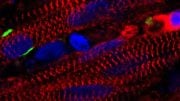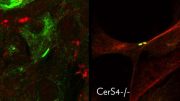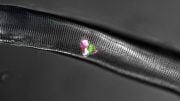
A hallmark of aging is a distinct characteristic that occurs in our bodies as we age and contributes to the decline in function and increased risk of age-related diseases. These hallmarks include changes at the molecular and cellular level, such as genomic instability, telomere shortening, epigenetic changes, and mitochondrial dysfunction, among others. Studying and understanding these hallmarks is crucial in the field of aging research and the pursuit of healthy aging.
A new mechanism of aging has been uncovered by researchers: the accumulation of sphingolipids. Ceramides, a widely known class of sphingolipids, build up in aging muscle and reduce its function, impacting the functional capacity of older adults. These findings inspire the development of potential drugs for the treatment of aging.
A joint study from the University of Helsinki and École Polytechnique Fédérale de Lausanne in Switzerland discovered that ceramides, a class of fat molecules known as sphingolipids, begin to accumulate in muscle during aging and hinder its function. Ceramides play a vital role in skin protection and are commonly found in skin care products. Despite their skin benefits, the impact of ceramides on aging has remained unclear until now.
As people age, the quantity of muscle tissue usually decreases and functional capacity is reduced. In the current study, the researchers observed that the number of ceramides and other sphingolipid molecules in muscle tissue increases when humans grow older. Because sphingolipids serve as cells’ internal messengers, this makes a difference.
“The link between sphingolipids and aging and its related diseases is a broad and fascinating subject, as they mediate a range of tasks in cells, including cell division and differentiation as well as insulin signaling,” says Pirkka-Pekka Laurila, MD, from the University of Helsinki and École Polytechnique Fédérale de Lausanne.
The study was recently published in the journal Nature Aging.
Reduction of ceramides boosts muscle strength and stem cell function
To begin with, the researchers investigated whether inhibiting ceramide production in cells could halt sarcopenia, or muscle loss associated with aging. They administered the drug myriocin, which is known to inhibit the production of ceramides, to the intraperitoneal cavity of aging mice. Myriocin slowed down sarcopenia in the mice, preserving their muscle strength and improving their balance and running capacity. It was found that the effects were related to muscle stem cell function.
Usually, the number of stem cells in muscles decreases as we get older. “We found that when ceramide production was inhibited, the number of muscle stem cells and their functional capacity was better preserved,” says Professor Johan Auwerx from École Polytechnique Fédérale de Lausanne.
In the mice receiving myriocin, stem cells more effectively differentiated into mature muscle fibers, increasing the number of white muscle fibers that maintain muscle strength and speed.
A marked role in human aging as well
Finally, the researchers wanted to study whether inhibition of ceramide synthesis could prevent muscle loss also in humans. They utilized thousands of samples collected from 70 to 80-year-old Helsinki residents in the extensive Helsinki Birth Cohort Study. The researchers found that 25% of the study subjects had a gene variant that had the same effect as myriocin, reducing the production of ceramides in the muscle.
“These older adults with a genetic mechanism for reducing ceramide synthesis in muscle tissue were fitter for their age, as manifested by increased handgrip strength and ability to walk long distances and stand up from a chair. This leads us to the conclusion that a pharmaceutical inhibiting the production of sphingolipids could be worth testing in humans,” says Professors Jari Lahti from the University of Helsinki, who was involved in the Helsinki Birth Cohort Study headed by professor Johan Eriksson.
The study opens up a new research line on the effect of ceramides and other sphingolipids in aging and provides encouragement for the development of potential therapeutic strategies involving sphingolipids also in humans.
Reference: “Sphingolipids accumulate in aged muscle, and their reduction counteracts sarcopenia” by Pirkka-Pekka Laurila, Martin Wohlwend, Tanes Imamura de Lima, Peiling Luan, Sébastien Herzig, Nadège Zanou, Barbara Crisol, Maroun Bou-Sleiman, Eleonora Porcu, Hector Gallart-Ayala, Michal K. Handzlik, Qi Wang, Suresh Jain, Davide D’Amico, Minna Salonen, Christian M. Metallo, Zoltan Kutalik, Thomas O. Eichmann, Nicolas Place, Julijana Ivanisevic, Jari Lahti, Johan G. Eriksson and Johan Auwerx, 16 December 2022, Nature Aging.
DOI: 10.1038/s43587-022-00309-6









Wondering if topical application of ceramide lotion ie in CeraVu are absorbed into the body increasing the likelihood of reduced muscle strength?
Exactly what I was thinking!